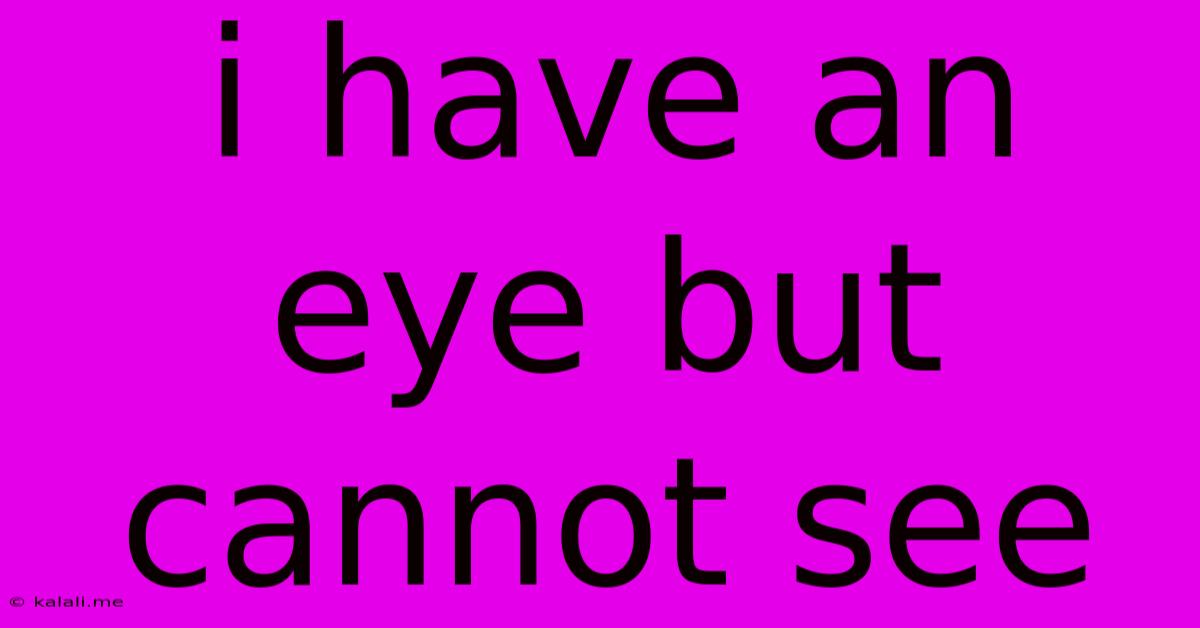I Have An Eye But Cannot See
Kalali
May 22, 2025 · 3 min read

Table of Contents
I Have an Eye, But Cannot See: Exploring the Riddle and its Deeper Meanings
This intriguing riddle, "I have an eye, but cannot see," has captivated minds for generations. While the most common answer is a needle, the riddle's power lies not just in its solution, but in the metaphorical interpretations it unlocks. This article delves into the various answers, exploring the symbolism and potential deeper meanings behind this classic brain teaser.
The Obvious Answer: A Needle
The most straightforward answer is a needle. Needles possess a hole at the tip, often referred to as an "eye," through which thread is passed. However, a needle itself lacks the capacity to see. This simple solution makes the riddle accessible to all ages, introducing the concept of figurative language in a playful way.
Beyond the Needle: Exploring Metaphorical Interpretations
While the needle provides a satisfying answer, the riddle's true charm lies in its capacity for deeper interpretation. The "eye" can represent various aspects of perception and understanding, leading to a spectrum of metaphorical answers. Consider these possibilities:
-
A Potato: While less common, a potato also has an "eye" – the bud from which a new plant grows. However, the potato lacks the ability to see in the literal sense. This answer introduces a slightly more unconventional and lateral thinking approach to the riddle.
-
A Storm: A storm can be seen as having an "eye"—the calm center of the storm. However, the storm itself cannot see. This interpretation elevates the riddle's complexity, suggesting a metaphorical connection between natural phenomena and the act of observation.
-
A Hurricane: Similar to a storm, a hurricane also features a distinctive "eye," yet it lacks the capacity of vision. This reinforces the thematic exploration of natural forces and perception.
-
Abstract Concepts: The riddle can even extend to abstract concepts. Think of something like a "perspective" or "point of view." A perspective can have a focal point, an "eye" if you will, but it cannot literally see. This opens the riddle up to philosophical discussions on perception and understanding.
The Riddle's Enduring Appeal
The enduring appeal of "I have an eye, but cannot see" stems from its simplicity and versatility. Its accessibility makes it a fantastic icebreaker, while its open-ended nature encourages creative thinking and deeper engagement. The riddle challenges us to move beyond literal interpretations, fostering critical thinking and metaphorical understanding. It demonstrates that a simple puzzle can hold layers of meaning, sparking conversation and prompting contemplation.
Conclusion: More Than Just a Game
While a needle provides the most common and readily accepted solution, the true value of the riddle "I have an eye, but cannot see" lies in its ability to inspire imaginative thinking and exploration of metaphorical language. Its enduring popularity highlights the human fascination with puzzles that blend simple wording with complex interpretations, enriching our understanding of both language and the world around us. So next time you encounter this riddle, don't just settle for the simple answer; let your mind wander and explore the possibilities!
Latest Posts
Latest Posts
-
Walking From St Pancras To Euston
May 22, 2025
-
Wouldnt Say Boo To A Ghost
May 22, 2025
-
How Long Does A Space Marine Live
May 22, 2025
-
Meaning Of How Are You Getting On
May 22, 2025
-
How Do You Say Be Nice In Spanish
May 22, 2025
Related Post
Thank you for visiting our website which covers about I Have An Eye But Cannot See . We hope the information provided has been useful to you. Feel free to contact us if you have any questions or need further assistance. See you next time and don't miss to bookmark.